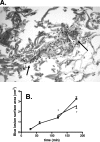Contributions of histamine, prostanoids, and neurokinins to edema elicited by edema toxin from Bacillus anthracis
- PMID: 17261611
- PMCID: PMC1865696
- DOI: 10.1128/IAI.01632-06
Contributions of histamine, prostanoids, and neurokinins to edema elicited by edema toxin from Bacillus anthracis
Abstract
Bacillus anthracis edema toxin (ET), composed of protective antigen and an adenylate cyclase edema factor (EF), elicits edema in host tissues, but the target cells and events leading from EF-mediated cyclic-AMP production to edema are unknown. We evaluated the direct effect of ET on several cell types in vitro and tested the possibility that mediators of vascular leakage, such as histamine, contribute to edema in rabbits given intradermal ET. ET increased the transendothelial electrical resistance of endothelial monolayers, a response that is mechanistically inconsistent with the in vivo vascular leakage induced by ET. Screening of several drugs by intradermal treatment prior to toxin injection demonstrated reduced ET-induced vascular leakage with a cyclo-oxygenase inhibitor (indomethacin), agents that interfere with histamine (pyrilamine or cromolyn), or a neurokinin antagonist (spantide). Systemic administration of indomethacin or celecoxib (cyclo-oxygenase inhibitors), pyrilamine, aprepitant (a neurokinin 1 receptor antagonist), or indomethacin with pyrilamine significantly reduced vascular leakage associated with ET. Although the effects of pyrilamine, cromolyn, or aprepitant on ET-induced vascular leakage suggest a possible role for mast cells (MC) and sensory neurons in ET-induced edema, ET did not elicit degranulation of human skin MC or substance P release from NT2N cells in vitro. Our results indicate that ET, acting indirectly or directly on a target yet to be identified, stimulates the production/release of multiple inflammatory mediators, specifically neurokinins, prostanoids, and histamine. These mediators, individually and through complex interactions, increase vascular permeability, and interventions directed at these mediators may benefit hosts infected with B. anthracis.
Figures





References
-
- Alton, E. W., and A. A. Norris. 1996. Chloride transport and the actions of nedocromil sodium and cromolyn sodium in asthma. J. Allergy Clin. Immunol. 98:S102-S105. - PubMed
-
- Annunziata, P., C. Cioni, R. Santonini, and E. Paccagnini. 2002. Substance P antagonist blocks leakage and reduces activation of cytokine-stimulated rat brain endothelium. J. Neuroimmunol. 131:41-49. - PubMed
-
- Bae, S. J., Y. Matsunaga, M. Takenaka, Y. Tanaka, Y. Hamazaki, K. Shimizu, and I. Katayama. 2002. Substance P induced preprotachykinin-a mRNA, neutral endopeptidase mRNA and substance P in cultured normal fibroblasts. Int. Arch. Allergy Immunol. 127:316-321. - PubMed
-
- Bardelli, C., G. Gunella, F. Varsaldi, P. Balbo, E. Del Boca, I. S. Bernardone, A. Amoruso, and S. Brunelleschi. 2005. Expression of functional NK1 receptors in human alveolar macrophages: superoxide anion production, cytokine release and involvement of NF-kappaB pathway. Br. J. Pharmacol. 145:385-396. - PMC - PubMed
-
- Bonuccelli, G., F. Sotgia, P. G. Frank, T. M. Williams, C. J. de Almeida, H. B. Tanowitz, P. E. Scherer, K. A. Hotchkiss, B. I. Terman, B. Rollman, A. Alileche, J. Brojatsch, and M. P. Lisanti. 2005. ATR/TEM8 is highly expressed in epithelial cells lining Bacillus anthracis' three sites of entry: implications for the pathogenesis of anthrax infection. Am. J. Physiol. Cell Physiol. 288:C1402-C1410. - PubMed
Publication types
MeSH terms
Substances
Grants and funding
LinkOut - more resources
Full Text Sources
Medical

